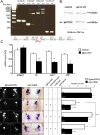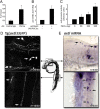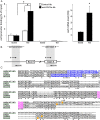The metabolic regulator PGC-1α directly controls the expression of the hypothalamic neuropeptide oxytocin
- PMID: 22016516
- PMCID: PMC6623572
- DOI: 10.1523/JNEUROSCI.1798-11.2011
The metabolic regulator PGC-1α directly controls the expression of the hypothalamic neuropeptide oxytocin
Abstract
The transcriptional coactivator PGC-1α is a key regulator of cellular energy expenditure in peripheral tissues. Recent studies report that PGC-1α-null mice develop late-onset obesity and that the neuronal inactivation of PGC-1α causes increased food intake. However, the exact role of PGC-1α in the CNS remains unclear. Here we show that PGC-1α directly regulates the expression of the hypothalamic neuropeptide oxytocin, a known central regulator of appetite. We developed a unique genetic approach in the zebrafish, allowing us to monitor and manipulate PGC-1α activity in oxytocinergic neurons. We found that PGC-1α is coexpressed with oxytocin in the zebrafish hypothalamus. Targeted knockdown of the zebrafish PGC-1α gene activity caused a marked decrease in oxytocin mRNA levels and inhibited the expression of a transgenic GFP reporter driven by the oxytocin promoter. The effect of PGC-1α loss of function on oxytocin gene activity was rescued by tissue-specific re-expression of either PGC-1α or oxytocin precursor in zebrafish oxytocinergic neurons. PGC-1α activated the oxytocin promoter in a heterologous cell culture system, and overexpression of PGC-1α induced ectopic expression of oxytocin in muscles and neurons. Finally, PGC-1α forms an in vivo complex with the oxytocin promoter in fed but not fasted animals. These findings demonstrate that PGC-1α is both necessary and sufficient for the production of oxytocin, implicating hypothalamic PGC-1α in the direct activation of a hypothalamic hormone known to control energy intake.
Figures




Similar articles
-
PGC-1alpha expression decreases in the Alzheimer disease brain as a function of dementia.Arch Neurol. 2009 Mar;66(3):352-61. doi: 10.1001/archneurol.2008.588. Arch Neurol. 2009. PMID: 19273754 Free PMC article.
-
Peroxisome proliferator-activated receptor-gamma coactivator-1alpha activation of CYP7A1 during food restriction and diabetes is still inhibited by small heterodimer partner.J Biol Chem. 2008 May 30;283(22):15089-96. doi: 10.1074/jbc.M710452200. Epub 2008 Apr 2. J Biol Chem. 2008. PMID: 18385139 Free PMC article.
-
Neuronal inactivation of peroxisome proliferator-activated receptor γ coactivator 1α (PGC-1α) protects mice from diet-induced obesity and leads to degenerative lesions.J Biol Chem. 2010 Dec 10;285(50):39087-95. doi: 10.1074/jbc.M110.151688. Epub 2010 Oct 13. J Biol Chem. 2010. PMID: 20947495 Free PMC article.
-
The role of PGC-1α in the pathogenesis of neurodegenerative disorders.Curr Drug Targets. 2010 Oct;11(10):1262-9. doi: 10.2174/1389450111007011262. Curr Drug Targets. 2010. PMID: 20840068 Review.
-
PGC-1α at the intersection of bioenergetics regulation and neuron function: from Huntington's disease to Parkinson's disease and beyond.Prog Neurobiol. 2012 May;97(2):142-51. doi: 10.1016/j.pneurobio.2011.10.004. Epub 2011 Nov 9. Prog Neurobiol. 2012. PMID: 22100502 Free PMC article. Review.
Cited by
-
The influences of parental diet and vitamin E intake on the embryonic zebrafish transcriptome.Comp Biochem Physiol Part D Genomics Proteomics. 2014 Jun;10:22-9. doi: 10.1016/j.cbd.2014.02.001. Epub 2014 Mar 1. Comp Biochem Physiol Part D Genomics Proteomics. 2014. PMID: 24657723 Free PMC article.
-
A Filtration-based Method of Preparing High-quality Nuclei from Cross-linked Skeletal Muscle for Chromatin Immunoprecipitation.J Vis Exp. 2017 Jul 6;(125):56013. doi: 10.3791/56013. J Vis Exp. 2017. PMID: 28715394 Free PMC article.
-
Ppargc1a Controls Ciliated Cell Development by Regulating Prostaglandin Biosynthesis.Cell Rep. 2020 Nov 10;33(6):108370. doi: 10.1016/j.celrep.2020.108370. Cell Rep. 2020. PMID: 33176142 Free PMC article.
-
The fenestrae-associated protein Plvap regulates the rate of blood-borne protein passage into the hypophysis.Development. 2019 Dec 2;146(23):dev177790. doi: 10.1242/dev.177790. Development. 2019. PMID: 31740533 Free PMC article.
-
Homeodomain protein Otp affects developmental neuropeptide switching in oxytocin neurons associated with a long-term effect on social behavior.Elife. 2017 Jan 17;6:e22170. doi: 10.7554/eLife.22170. Elife. 2017. PMID: 28094761 Free PMC article.
References
-
- Adan RA, Cox JJ, Beischlag TV, Burbach JP. A composite hormone response element mediates the transactivation of the rat oxytocin gene by different classes of nuclear hormone receptors. Mol Endocrinol. 1993;7:47–57. - PubMed
-
- Amico JA, Vollmer RR, Cai HM, Miedlar JA, Rinaman L. Enhanced initial and sustained intake of sucrose solution in mice with an oxytocin gene deletion. Am J Physiol Regul Integr Comp Physiol. 2005;289:R1798–R1806. - PubMed
-
- Blechman J, Borodovsky N, Eisenberg M, Nabel-Rosen H, Grimm J, Levkowitz G. Specification of hypothalamic neurons by dual regulation of the homeodomain protein Orthopedia. Development. 2007;134:4417–4426. - PubMed
-
- Blevins JE, Schwartz MW, Baskin DG. Evidence that paraventricular nucleus oxytocin neurons link hypothalamic leptin action to caudal brain stem nuclei controlling meal size. Am J Physiol Regul Integr Comp Physiol. 2004;287:R87–R96. - PubMed
-
- Bradford Y, Conlin T, Dunn N, Fashena D, Frazer K, Howe DG, Knight J, Mani P, Martin R, Moxon SA, Paddock H, Pich C, Ramachandran S, Ruef BJ, Ruzicka L, Bauer Schaper H, Schaper K, Shao X, Singer A, Sprague J, et al. ZFIN: enhancements and updates to the Zebrafish Model Organism Database. Nucleic Acids Res. 2011;39:D822–829. - PMC - PubMed
Publication types
MeSH terms
Substances
LinkOut - more resources
Full Text Sources
Molecular Biology Databases
